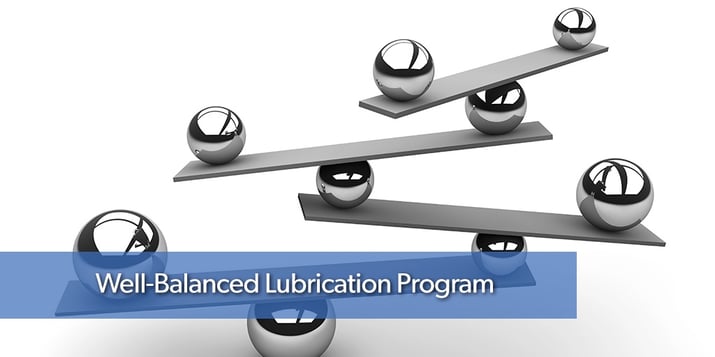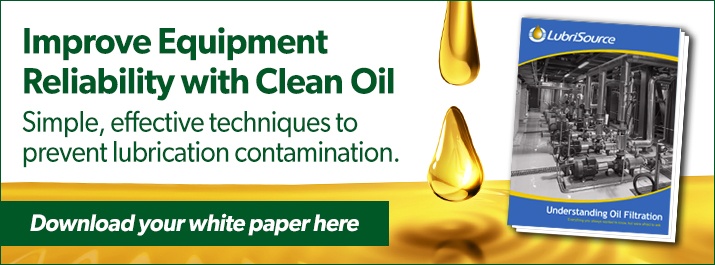
A reliability-based lubrication maintenance strategy requires a well-balanced program of proactive, preventive, predictive, and reactive contamination control measures. No plan, person, or piece of equipment is perfect, but incorporating a few simple techniques into your maintenance schedule can help you stay two steps ahead of equipment failure due to lubrication or filtration contaminants.
Oil Filtration and Lubrication Contaminants
Poorly maintained or unmonitored machinery in any manufacturing plant will suffer from contaminated lubricants that cause wear and equipment failure. it’s been found that particle contamination is the leading cause of lubricant-related failure in equipment. Approximately 82% of wear is particle-induced, and abrasion wear accounts for two-thirds of that figure. Additionally, the presence of one contaminant can cause a chain reaction that compounds the adverse effects of another.

Determining how lubricants are contaminated helps you design ways to avoid them. Here are several common ways contaminants are introduced into your lubrication system:
- Air: Poor machine design, improper reservoir size or shape, line restrictions, standpipes or elbows, prolonged equipment shut-down, water contamination.
- Water: Leaks or condensation from faulty or improperly designed storage and reservoirs, leaking heat exchangers or coolers, direct infiltration from process water, air contamination.
- Varnish: Temperature/thermal stressing, oxidation resulting from water contamination, prolonged equipment shut-down.
- Debris: Improper transfer, poor atmospheric quality, changing filters too often or too infrequently, internal component wear.
Hydraulic and Lubrication Systems Contamination Control Solutions
A predictive approach is highly effective when it comes to oil filtration and lubricant contamination control in your manufacturing facility. This requires getting to know your machinery, understanding component tolerances, and formulating a plan based on reliability.
Here are several proactive measures you can implement to ensure less equipment downtime, fewer wasted man-hours, and increased plant productivity:
- Control of contamination in your manufacturing plant begins with education, including knowing the types of contaminants you're likely to experience, the signs that contamination is present, the potential consequences if it goes unchecked and unmitigated, and the solutions available to you to predict, prevent, and rectify contamination.
- Scheduling lubricant and filter changes according to condition is particularly beneficial in controlling debris and varnish formation. Changing your filter or lubricants too often increases the risk of introducing debris, and changing them too infrequently increases oxidation, the catalyst for varnish formation.
- Excess air is considered the most destructive of lubrication contaminants, damaging the oil as well as the machinery. The system should be monitored and sampled regularly for signs of foaming.
- Test new fluids before introducing them into the system to ensure they are initially contaminant-free. Likewise, regularly test stored bulk fluids for signs of contamination, particularly water and debris.
- Install adequate facility air filtration and ventilation to ensure that potential atmospheric contaminants are kept to a minimum, and monitor air quality regularly.
- Facility cleanliness is key for the reduction of debris contamination. Prioritize your plant's janitorial maintenance program and educate the department on the significance of their contribution to contamination control.
- Monitor the effectiveness and structural condition of all storage and transfer equipment. Leaking seals, covers, and poor design are potential avenues through which water and debris contaminants are introduced.
- Used oil analysis will tell you a lot about what's happening inside your system and could very well be the first indicator that a contamination problem is looming. It will help you determine the long-run health of your lubrication system, as well as help to identify internal component wear, malfunctions, or design flaws.
- A key technique in your successful contamination control strategy is to study and monitor the performance of the machinery's components to predict the impact they will have on the health of the lubricant and vice versa.
Developing a viable program for your manufacturing plant's lubrication contamination control management doesn't have to be an overwhelming project. We can help you educate yourself and your department, and test, assess, and advise you on effective maintenance scheduling and techniques for contamination remediation. Why risk equipment failure and shutdown when you can preempt it with a solid plan? Include LubriSource in your reliability-based maintenance strategy to keep your operation and your equipment up and running smoothly.








